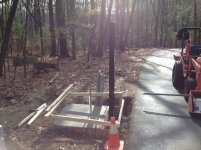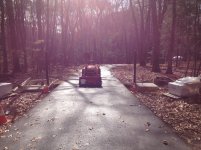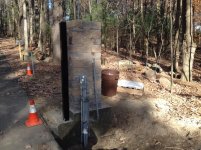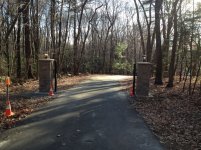OP
tractchores
Veteran Member
Here are some pictures of the final bore trenches and where the gate will be located.
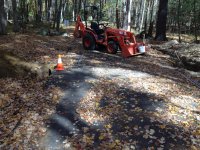
Gate location will be where the cone is. The bore will be right near the gate posts, probably just far enough so the cement doesn't encase the conduit. Everything will be tied in to a junction box and control box, which will be on the right side next to the gate post and hidden by a stone column, which i will build after the gate posts are cemented.
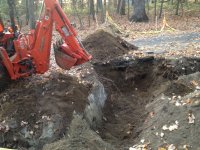
Entrance trench. This is a bit bigger than needed as it's where all the conduit runs will come together for the junction box. I'll have 6 conduit runs coming together here, which should make it interesting to wire up. Dimensions had to be 4' x 4' x 3' deep. The bore is at the very bottom of the hole, so nice and deep, which will prevent an issue if the driveway is redone.
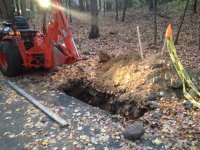
exit trench and far gate post hole. The dimensions are 4' x 16" x 4'. I made it a bit deeper to give a bigger target. A gate post will go in here and wiring for the slave opener and another stone post and light will be run through. I sleeved schedule 80 PVC inside HDPE pipe, which is what the NEC requires for 'boring' installations.
I believe that the digging part is almost done!

Gate location will be where the cone is. The bore will be right near the gate posts, probably just far enough so the cement doesn't encase the conduit. Everything will be tied in to a junction box and control box, which will be on the right side next to the gate post and hidden by a stone column, which i will build after the gate posts are cemented.

Entrance trench. This is a bit bigger than needed as it's where all the conduit runs will come together for the junction box. I'll have 6 conduit runs coming together here, which should make it interesting to wire up. Dimensions had to be 4' x 4' x 3' deep. The bore is at the very bottom of the hole, so nice and deep, which will prevent an issue if the driveway is redone.

exit trench and far gate post hole. The dimensions are 4' x 16" x 4'. I made it a bit deeper to give a bigger target. A gate post will go in here and wiring for the slave opener and another stone post and light will be run through. I sleeved schedule 80 PVC inside HDPE pipe, which is what the NEC requires for 'boring' installations.
I believe that the digging part is almost done!
